Stocked Valves
We stock a range of triodes and pentodes that we recommend and have tested in our amplifiers and pre-amps.
Download our valve order form
All valves are new, old (or original) stock (NOS), not re-released valves and were
purchased from Russian government surplus stores and auctions. Most were bought and supplied in their original factory boxes.
Some older valves are marked with the Cyrillic CCCP logo (SSSR; Soyuz Sovietskikh Sotsialisticheskikh Republik, the former Union of Soviet Socialist Republics or USSR).
Many of the Military or MIL grade valves bear the OTK stamp from military quality inspection. Some, typically rarer, more expensive valves, were bought in lots/quads when they could be found.
All of the valves we stock sound fantastic and the differences between the sound produced by each type are very subtle.
In the input stage we have also tested NOS Tesla, Philips and Siemens E88CC and new Electro-Harmonix 6922EH Gold - which are very similar (identical?) to the original Reflektor 6N23P-EV.
In the outputs, as well as the superb Reflektor 6P14P range that we recommend and stock for the SAM-A1, we have tested successfully with original Mullard EL84s, original Cossor 6BQ5s as
well as new Bugera and Electro-Harmonix EL84s.
The SAM-A2 uses the EL34 and compatible pentodes and beam tetrodes. Pentodes tested include Mullard and Electro-Harmonix EL34s, Shuguang EL34-Bs and Shuguang 6CA7-Zs.
Beam tetrodes that we have tested and recommend include the excellent Electro-Harmonix 6CA7, Genalex Gold Lion and JJ KT77s as well as the superb (lower power output) Reflektor 6P6S and Guigang 6P3P-J (which we stock).
For fun we have also tried old Reflektor 6P6S beam tetrodes and new JJ KT66s - they work - but we do not recommend them in the SAM-A2.
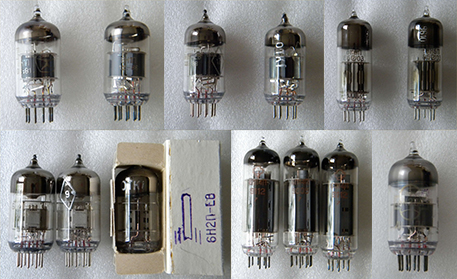
Ordering Valves
The conflict in the Ukraine means the supply of all new and NOS valves from Russia had been banned. E.g. New Sensor (tooling from the former Reflektor plant in Saratov) who make valves branded as Tung-Sol,
Electro-Harmonix, EH Gold, Genalex Gold Lion re-release, Mullard re-release, Svetlana and Sovtek. Apparently the ban was lifted but supplies are still under threat and valve stocks still appear to be limited and
prices are certainly rising.
It is believed that JJ (in Solvakia) and one supplier in China (PSVANE) are still producing new stock, as are the few really niche, hand-made manufacturers.
The Shuguang Electron Tube plant in China closed in 2019 and it is not known when (or if) construction of a new plant will start. The Shuguang Electron Tube stock that is currently available seems to be very
dubious, as does new stock from PSVANE (see More Information below).
We have stocks of all of the valves we list - and as yet we have not increased our prices since 2021. We will have to monitor demand and should our stocks run low to the point
that we have concerns about our ability to support our own products, we may have to increase our prices or remove certain types from our catalogue.
If the valve you are looking for is not listed in the tables below – please do ask – we may be able to help, point you in the direction of a supplier or procure a stock for you and test them/match them to your needs.
If a valve we stock is available in its original individual box, the listing will state NIB, otherwise the valves will be supplied individually wrapped for protection.
New boxes are available for non-NIB valves if requested, at £1 each for a triode, £2 for a Pentode box). If listed as Bulk - the valves were bought in their original factory boxes of 50, 100 or 200 valves.
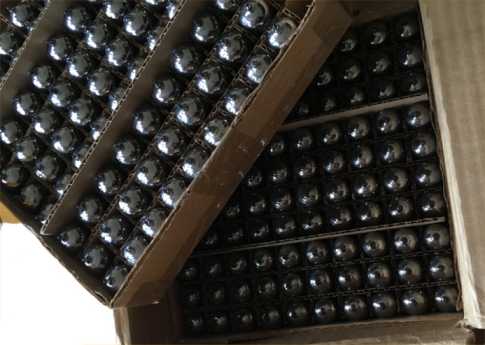
All valves are thoroughly tested before dispatch to ensure they perform as expected (for their type and age) both in bespoke test equipment for comparison with their datasheet and in our products,
for their sound quality.
If valves are bought in pairs/quads for use in our amplifiers then they will be supplied with basic matching to work with our products.
This means they will be matched, for current gain (transconductance) or signal gain, depending on their application and where it matters, to within 10% of each other.
Premium matching is available, at an extra £6 per valve, if matching accuracy of 5% or less is desired.
Please do talk to us about valve choice and matching, tell us what your application is (if not for one of our products) and we will endeavour to provide valves that are matched accordingly.
(E.g. an amplifier whose output valves are used in individually set, fixed bias, will have different requirements when compared with an amplifier where the valves are used with self or cathode bias, with little or no adjustment available).
Datasheets are available for all stocked valves on request.
The following is the list of valves we stock, for current prices, please download our order form.
The valves we stock are intended for use in our products and will only be sold in small quantities.
Prices are inclusive of VAT which will be charged at the rate applicable at the date of sale, currently 20%. Postage and packing will be charged depending on the number of valves purchased and the
service required, e.g. First or Second Class, Signed for, Parcel Force Tracked 48hr etc.
Triodes (double triodes)
(Click on image thumbnails to view a larger picture)
Getter Supports: S (Non-MIL version Single), D (MIL ruggedized Double), T (MIL ruggedized Triple)
Pins: S (Silver - Nickel plated), G (Grey - un-plated)
| Image |
Valve/Tube |
Cyrillic/OEM |
Brand |
Date Codes |
OTK MIL |
Getter Support |
Pins |
Box |
Comments/Description/Observations |
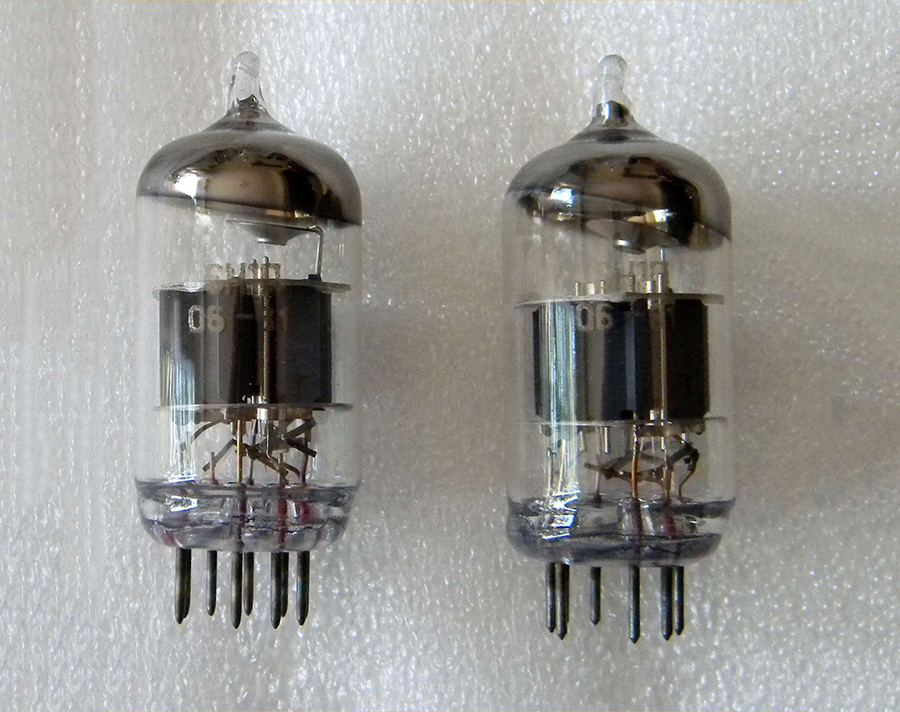 |
6N1P |
6H1П |
Russian |
Various |
|
S |
G |
Bulk |
These are Voskhod (Kaluga) but have no rocket logo, great sounding valves. 3000 hr life. The 6N1P is a direct replacement for the Chinese 6N1 double triode. |
 |
6N1P |
6H1П |
Voskhod |
'81 & '86 |
|
S |
G |
Bulk |
The classic 6N1P tube from Voskhod (Kaluga) great sound. 3000 hr life. |
 |
6N1P-EV |
6H1П-EB |
Voskhod |
'84, '88 & '90 |
Yes |
D |
S |
Bulk |
MIL ruggedized version of the 6N1P, a great valve. Extended life 5000hr. |
 |
6N1P-EV |
6H1П-EB |
Nevz |
'72 |
Yes |
D |
S |
Bulk |
Nevz (Novosibirsk) version of the 6N1P-EV. |
 |
6N1P-VI |
6H1П-BИ |
Nevz |
'88 & '90 |
Yes |
D |
S |
NIB |
The 6N1P-VI version is optimised for pulse operation, i.e. high peak current. Great for a driver or low power triode output stage; impeccable as your input gain stage. MIL ruggedized, 3000hr. |
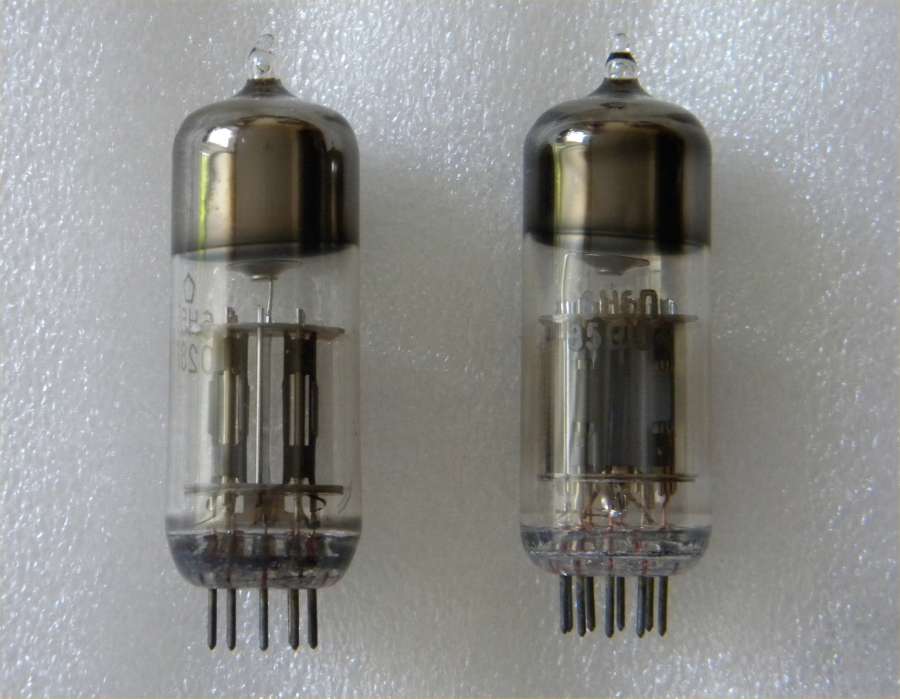 |
6N6P |
6H6П |
Nevz |
'80 to '87 |
|
S |
G |
Bulk |
Taller tube, higher power, lower gain, double triode, designed for audio. Great as an input gain stage, driver or triode output. Sounds similar to the 6N23P-EV i.e. excellent! 2000hr. |
 |
6N6P |
6H6П |
Nevz |
'86 |
Yes |
D |
S |
Bulk |
If you have plenty of input signal amplitude, the 6N6P is a great valve for your input gain stage. With a power rating of 4.8W/triode (8W total) the 6N6P is also perfect as a driver or triode output. 2000hr.
These are all MIL OTK inspection stamped. |
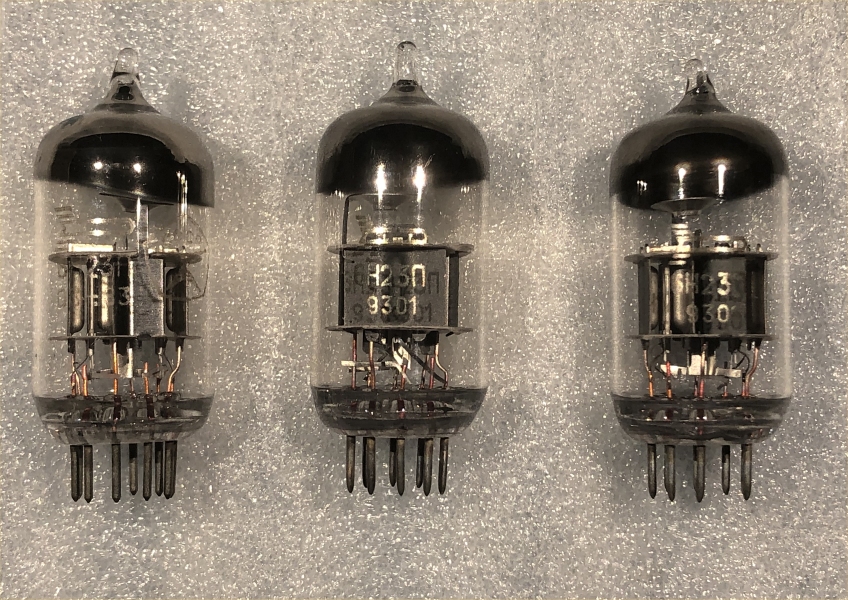 |
6N23P |
6H23П |
Voskhod |
1978 1980 1983 1993 |
|
S |
G |
Bulk
|
The basic 6N23P valve from Voskhod all with the rocket logo - the earlier ones also bear the CCCP (SSSR) logo. Very open frame anode, heated cathode and grid clearly visible -
very attractive valve with a fantastic sound. 3000hr. |
 |
6N23P |
6H23П |
Reflektor |
'67 to '74 |
Yes |
D |
G |
Bulk
|
A rare, MIL ruggedized, Reflektor (Saratov) version of the basic 6N23P valve. Fully boxed anode, fantastic sound. (These are older valves; some of the logos and stamps are worn). Originally rated for 5000hrs. |
 |
6N23P-EV |
6H23П-EB |
Reflektor |
'73 to '90 |
Yes |
D |
S |
New/ NIB |
Best of the bunch. Reflektor (Saratov) Military ruggedized, extended life version. Stunning sound, real clarity and depth of sound. 5000hr. |
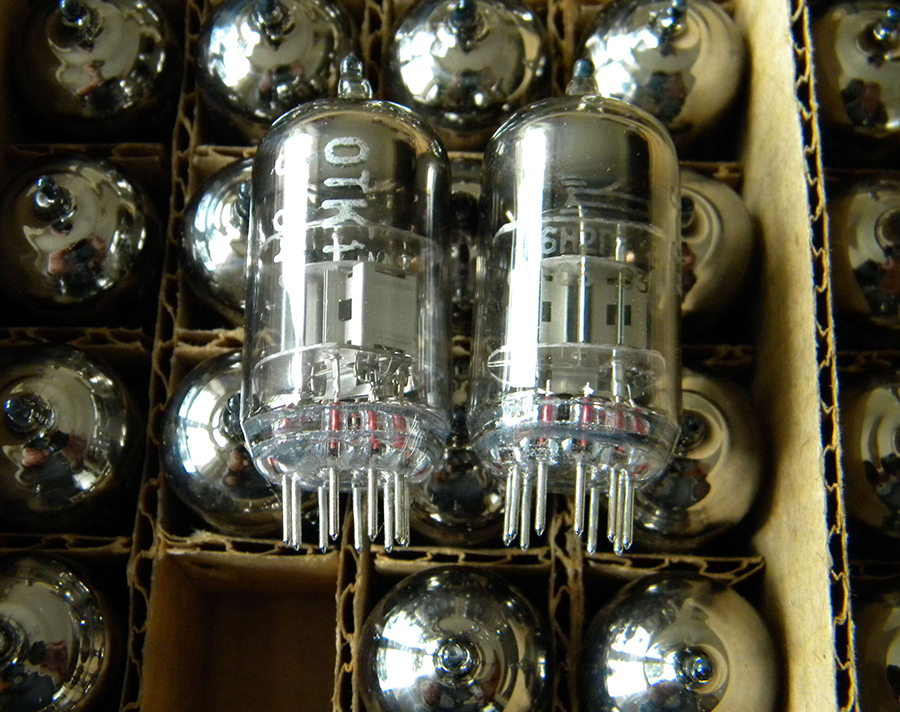 |
6N2P-EV |
6H2П-EB |
Voskhod |
'83 |
Yes |
D |
S |
Bulk/ NIB |
Higher gain for lower input signal applications. Impeccable sound, Military ruggedized, extended life, in a factory box. 5000hr |
 |
6N2P-EV |
6H2П-EB |
Voskhod |
'82 |
Yes |
D |
S |
NIB |
Higher gain, for lower input signal applications. Impeccable sound, Military ruggedized, extended life, in original boxes. 5000hr. |
 |
6N3P-E |
6H3П-E |
Reflektor |
12-85 01-86 |
Yes |
D |
S |
NIB same batch |
Similar gain characteristics to the 6N1P/6N23P, great sound, with a 'normal' heater current but a DIFFERENT pinout compared with the 6922 types. These are the extended life variant, originally rated for 5000hrs. |
Pentodes and Beam Tetrodes ('Kinkless' Tetrodes)
(Click on image thumbnails to view a larger picture)
| Image |
Valve/Tube |
Cyrillic/OEM |
Brand |
Date Codes |
OTK MIL |
Getter Support |
Pins |
Box |
Comments/Description/Observations |
 |
6P14P |
6П14П |
Reflektor |
'80 to '91 |
|
S |
G |
Bulk |
The Reflektor (Saratov) 6P14P pentode is a great equivalent to the 6BQ5/EL84 pentode (some 6BQ5 are actually beam tetrodes) but with
higher power capability, (14W not 12W anode power). 3000hr |
 |
6P14P-EV |
6П14П-EB |
Reflektor |
'83, '84, & '89 |
Yes |
T |
S |
NIB/ Bulk |
Extended life, ruggedized version of this great pentode. Often re-branded as a premium EL84 or 7189 tube. 5000h. |
 |
6P14P-ER |
6П14П-EP |
Reflektor |
'90s and 91-11 |
Yes |
T |
S |
NIB/ New Box |
The ultimate 6P14P/EL84/6BQ5 pentode, only ever available for military use, 10,000hr rated. Simply the best of its type available. Like the 6P14P-EB - these are often re-branded.
These are the original Reflektor 6P14P-ER valves. |
 |
6P3S |
6П6C |
Reflektor |
1982 & 89/90 |
Yes |
S |
S |
NIB/ Bulk |
Russian Military output beam tetrode- not to be confused with the -E variant which has much lower Anode and second grid voltage. This is a very good, solid valve. Near Equivalents; 6L6, 6L6GT, 6L6GC, 5881. |
 |
6P3P-J |
|
Guigang |
95 |
|
S |
S |
NIB |
Big bottle Chinese output beam tetrode from the factory that was (allegedly) bought by PSVANE. A beautiful valve to look at - and it sounds good too.
All are tested thoroughly. Near Equivalent; 6L6GC. The -J denotes a higher level of quality screening. |
 |
EL34B |
|
Shuguang |
unspecified |
|
S |
S |
NIB |
Big bottle Chinese output pentode All are tested thoroughly; soaked at 450V 20W and screened at 500V on anode. |
 |
EL34C |
|
PSVANE |
unspecified |
|
S |
S |
NIB |
Big bottle Chinese output pentode All are tested thoroughly; soaked at 450V 20W and screened at 500V on anode. |
 |
EL34C, EL34-Z, EL34-PH, 6CA7-TII, EL84S |
|
PSVANE |
unspecified |
|
S |
S |
NIB |
See "More Information" below |
Download our valve order form
Equivalence
We are often asked about equivalence - 'can I fit one of these instead of one of those?' - The answer is seldom a simple yes or no; it largely depends on the design of the equipment the valve is being
used in, how the design biases the valve (which valve it was intended to be used with) and the capability of the power supplies powering the heaters (or filaments) and providing the anode-cathode current.
You cannot necessarily just interchange these valves and expect them to work well/optimally – they may well need a different bias and set up – i.e. a different anode load (Ra), kathode (or cathode) load (Rk)
and (anode) supply voltage to work as intended .. If the bias point and load line are not optimised, swapping one valve type to another may reduce or increase the gain but may well introduce
significantly more harmonic distortion. Worst case it could cause a valve to draw too much current and operate outside of its safe operating area i.e. it won’t work at all well and not for long!
This is often what leads to statements about one type of valve sounding better than another - if the replacement valve is not biased optimally or even correctly, it will not sound as good as it is capable
of sounding and may well sound worse than an older or worn out valve that is at least biased correctly!! Just because the pin-out is the same does not make one valve interchangeable with another type.
What you can say, is that some valves are 'sensibly equivalent to' another type, based on the pinout and valve characteristics e.g. transconductance (S or Gm) amplification factor and voltage ratings etc.
There is one essential difference and that is that the 12AT/AU/AX and the ECC81 82 83 all share a dual voltage, centre-tapped heater, wired between pins 4 and 5, with a centre tap on pin 9. If they are
operating from 12.6V then pin 9 will have no connection, with 12.6V connected across pins 4 and 5; if operating from 6.3V then pins 4 and 5 are connected together and the heater voltage is across pins
4&5 with respect to pin 9.
The 6N 1P,2P,23P and 6P are all 6.3V heaters only, connected across pins 4 and 5, with pin 9 being used as a 0V screen between the two triode halves (which we like!).
The Russian types nearly all pull more heater current than the European or American 'equivalents' with the exception of the 6N2P, 6N3P and 6N23P which are similar:
The 6N2P pulls 315 to 365mA, the 6N23 pulls 285 to 335mA and the 6N3P pulls 320 to 380mA. The 6N1P range pull 550 to 650mA heater current and the 6N6P pulls 700 to 800mA.
Even if your amp uses 6.3V and not 12.6V, you will have to check that the mains transformer/dc heater supply is up to the increased load.
If you plug a 6N1/2/23/6P valve in a 12XX7 socket at best nothing will happen. It is relatively easy to add in a switch to select one type or the other (to change the heater connections) provided the
12XX system is using 6.3V – if it’s using 12.6V, then you need to wire the heaters of two 6.3V types in series… but, the bias/set-up may still be wrong!
So - apart from the heater voltages/connections/current:
The 6N1P is sensibly equivalent to the E88CC 6N23P/6922 and probably more so the ECC88.. but has a lower amplification factor µ (gain) than the 6N23P/6922.
The 6N3P is sensibly equivalent to the Chinese 6N3; 2C51, 396A, 5670, CV4013, CV2831, 6CC42. This has a DIFFERENT pinout compared with the 6922 types and is therefore not compatible with our amps or pre-amps without an adapter.
12AT7 is sensibly equivalent to the ECC81; µ = 54 – 62 and 60 – 70 respectively; S(Gm) = 4.5-5 and 3.76 – 6.7; No really close Russian equivalent that I have come across/use; the 6N1P has a similar
transconductance (S) but lower anode resistance (ra) and amplification factor (µ)– this means lower gain.
12AU7 is sensibly equivalent to the ECC82 µ = 17 – 19.5 for both; S = 2.2 – 3.1 for both; 6N6P has a µ of 18-26 but a higher S(Gm) (8 – 13.4) and will require completely different bias and anode
loads (Rk and Ra) (as well as pulling a lot more heater current).
12AX7 is sensibly equivalent to the ECC83 µ = 100 for both, S = 1.25 – 1.6 for both; very similar to 6N2P-EV; µ = 100, S = 1.6 – 3.05
6P14P range is sensible equivalent to the EL84 and 6BQ5 (but capable of more anode power than both!)
6P3S is sensibly equivalent/similar to the 6L6, 6L6GT, 6L6GC, 5881.
6P3P-J is sensibly equivalent/similar to the 6L6GC.
EL34B is as good as or better than a standard EL34 - but not quite as beefy as a true 6CA7 (e.g. the Electro-Harmonix EH6CA7).
EL34C is an 'improved' version of the EL34.
The only way to be really confident if you can use a valve of a given type is to compare the datasheets of the valves being considered - look at their characteristics and the load curves and see if the
existing design suits them, - or change the design to suit them and then verify by measurement. (We can provide the datasheet for all the valves we stock on request).
More information
We stock high quality commercial and MIL grade, ruggedised valves. In addition to an increased level of testing and quality inspection during production,
MIL grade valves employ a number of techniques to make them more resistant to vibration in service. This is not essential for domestic audio use but there
are advantages which include: higher quality, often an extended rated useful life as well as lower microphonics.
'Microphonics' is the term used to describe what happens when external vibrations, including loud music, are transferred mechanically to the internal components
of the valve so it acts like a microphone, adversely affecting audio quality.
We have not experienced any microphony problems with any of the valves we stock for use with our products.
We are looking for EL34 compatible pentodes/beam tetrodes that we can recommend for use in, stock and sell for the SAM-A2 as a potential alternative to Russian-sourced products (or very expensive and now rare NOS quads).
We looked to China for a source of reasonably priced pentodes/beam tetrodes, since the original quad of Shuguang EL34-B pentodes and the Guigang 6P3P-J that we have are superb. Sadly, subsequent batches of EL34-Bs we have
procured from China have been of very poor quality. They were not bought from the factory since it closed in 2019.
We noticed that the later valves have red lettering and have a taller bottle than the original quad we had with white lettering. Since the Shuguang factory closed in 2019 - perhaps these
valves are 'fakes' or production rejects, or have simply been handled/stored very poorly. We believe however that the problem is very poor manufacturing quality; we are leaning towards fakes or rejects.
We are seeing 3rd (suppressor) grids that are not concentric with the anode plates.
This can be seen (with relatively low risk to the test set up) with the naked eye as an uneven blue glow on the suppressor grid when the valve is conducting at 250V (visible through the holes in the anode box).
In extreme cases there is no glow on one side at all (all the current flowing through the side closest to the anode). This leads to uneven power dissipation in the anode plate and anode plate glow
on one side only at significantly less than maximum rated power (i.e. half!!).
Worse, this poor construction can be seen to cause hot spots (bright spots) visible on the suppressor grid where it comes closest to the anode plate and worse still we have had valves fail to short at
400V (rated to 800V!) in a development amplifier causing considerable damage.
Out of the box, some had no output at all or intermittent output (poor pin soldering suspected) and some had shorts.
Not good and very disappointing. More than 50% of the valves supplied we would reject, certainly they were very far from 'matched quads' as advertised.
We believe the problem may be that many testers (including our own basic tester) only test the valves at 250V on the anode, or worse, only do a pulse test, in which case, perhaps many of the faults we are seeing are not found.
(This however, does not explain the valves that had shorts or were open-circuit straight out of the box, that we found on our basic tester. Perhaps handling in transit may explain this - perhaps I am being over-generous!?).
We have also looked at PSVANE EL34C and the PSVANE EL34PH. The EL34PH is described as a perfect replica of the original Philips EL34.
We have only tried two quads of the EL34PH (because they are not cheap) and in fairness, they were all serial-numbered and supplied with a test certificate showing they were tested at Va=450V, -Vg1 = 40V
with a recorded Anode current of 40mA i.e. 18W (and in a very nice box!). All bar one out of 8 valves seem perfect at 25W and 500V on the anode and they were well matched (<3%).
One valve from the second quad was a dud - o/p very low and falling - this was replaced with another (after a bit of quibbling with the vendor, not PSVANE!) and we now have two good quads - not one that I am going to be buying in bulk!
The PSVANE EL34C were not as good as the EL34PH. They are better, on the batch we have tried so far, than the Shuguang EL34Bs - but we still had a 17-34% reject rate when tested at 450 and 500V.
Any Quads that we are selling, therefore, will have been soak-tested at 250V and 450V on the anode (screened to 500V) and at 20W or 25W Anode plate dissipated power and are suitable for use in the SAM-A2.
All sound very similar with a slightly stronger low end from the EL34Bs. The PSVANE EL34PH are a very sleek-looking and clean sounding EL34 - we love the look of the EL34-Cs with their big anode plate holes that allow
a lot of the internal structure and ethereal blue glow to be seen.
Overall an interesting - if expensive - exercise - especially when you consider that all of the ElectroHarmonix EL34s, 6CA7s, Genelex and JJ KT77s and JJ EL34 ranges we have tried have all been perfect out of the box.
We are now talking directly with PSVANE.
Update June 2025 – Last year, a reasonably large order was placed with PSVANE directly.
Batches of EL34-C, EL34-Z, EL34-PH 6CA7-TII and EL84-S were ordered and delivered without problems.
Sadly on testing (the 6CA7-TII have not been tested yet – I lost heart before getting to them!) exactly the same problems have been seen as were seen with Shuguang and PSVANE valves bought from other vendors. A similar imperfection rate was seen and the same problems – manufacturing quality-related, non-concentricity of the cage components – hot spots on the suppressor grid, anode plate glow on one side at full power - although as yet, at least none that are open or short circuit out of the box. Valves that I would reject ranged from 20% (EL34-PH) to 50% (EL34-Z) – 6CA7-TII not yet tested
Disappointingly the supplier has been unforthcoming on discussions about this problem and I do not expect to get my money back or replacements for the ‘defective’ tubes.
Worryingly – to the layman who does not know how to, or has not got the equipment to test these valves thoroughly – on face value, they appear to work very well, and they do – right up to the point they don’t. Premature failures especially a short from anode to grid 3 (connected to the cathode) may well damage equipment. To re-iterate; any valves we sell will have been screened to the best of our capability and this will have to be reflected in the price.
As well as the screened EL34-B and EL34-C, EL34-Z, EL34-PH 6CA7-TII and EL84-S valves we do have limited stocks of JJ EL34 and EL34II, Electro-Harmonix EL34 and 6CA7, Genalex Gold Lion (reissue) KT77s and JJ KT77s. If you are interested in these - please get in touch.
For the moment the SAM-A2 will be supplied either configured for the Reflektor 6P3S or Guigang 6P3J or set up for EL34s and allow you to request a Quad from what we have in stock. If you supply your own quad we will insist on testing it before we fit it the amp.
'Military' grade valves
How are MIL spec valves made more rugged? We'll start with the 'cage'. The cage is the internal body of the valve where the components of the valve (anode plates,
heated cathode, heaters and grids) are supported between the top and bottom Mica supports. It is quite delicate.
MIL grade valves tend to have higher quality connections between the pins in the base of the valve and the components in the cage and don't just rely on these
connections to support the cage but have additional supports to the pins.
MIL grade valves often use double or even triple layers of Mica for the top and bottom of the cage.
These Mica plates hold the valve components in place, maintaining the small gaps between the anode, cathode and grid and isolate them from the glass envelope, or tube.
The heated cathode and plates of the anode will have more support, often being completely 'boxed' in so the grids and cathodes are barely visible and the getter ring/plate
will have more than one mechanical support.
The 'getter' is the very thin layer of reactive metal deposited on the inside of the valve glass body (by induction heating the getter material). The getter's appearance
varies, is usually silver, like a mirror, on the inside of the valve and darker looking from outside the valve.
The reactive metal of the getter traps atoms of reactive gas left behind in the vacuum in the valve improving (or hardening) the vacuum and so life and performance of the valve.
If the getter is transparent, blotchy or white, it's a sure sign of a broken vacuum and if the valve is still working, it may not be for long!
Note that even if the getter looks perfect, the vacuum in the glass tube is never perfect (that's very hard to achieve, even in space!) and over time smaller atom size
gasses can leak in past the vacuum seals. In extreme cases valves can become 'gassy' as the vacuum gets weaker - this can cause an abnormal amount of blue luminescence to be
generated in the valve when its working (some blue luminescence is not a problem and can look very attractive!)
As to whether or not Military grade valves sound better - this is a very subjective topic and again there are a lot of fact based theories and even more opinions on this.
All we are prepared to comment is that they should last considerably longer than a commercial equivalent (and they are quite a lot harder to break if you drop one by mistake!)
Valve Operational Life
Valves are very similar to old-style tungsten filament lamps - they have a finite life - they are a consumable. (The Russian for a valve is Lamp!).
The rated 'life' of the valve is VERY dependent of how hard they are driven (typically how close to maximum power and/or heater voltage) and is the minimum rated operational life
of the valve specified by the manufacturer.
It varies as to whether this is specified at normal operating conditions, or at maximum power, maximum heater volts and worst case operating conditions (more applicable to MIL valves).
Over a long time (i.e. decades) the performance of the valve can degrade - even (especially!) if it's never switched on and the rate of degradation depends, to a degree, on how well
the valve has been stored (constant temperature and humidity) before we got them. This is usually seen on test, by a valve having a lower emission than specified, i.e. it conducts
less current for a given anode and grid voltage than specified and exhibits a lower transconductance (mA/V) - Ia and S (or gm). We have also seen higher anode resistance (Ra) - this
can also mean that the valve generates a higher voltage gain and may produce more noise (hiss).
This is why we test all of our valves and why the rated life cannot be guaranteed.
One of the ways that MIL spec valves can achieve an extended operational life is to limit the range of acceptable heater voltages that can be used. Typically a MIL spec valve will
state a heater voltage in the range 6.0 to 6.6V where a commercial equivalent is rated for 5.7 to 7.0V. This only really has an impact on the importance of selecting the correct
mains transformer input tap for the amplifier's mains supply. Higher heater voltages mean higher current gains, but lower valve life!
This is less of a problem for input and driver valves, which, provided the heater volts are correct, are hardly stressed and will last for many years.
The life of the output valves will depend on how the amplifier is configured.
If the amplifier is set for pure Class A push-pull, for example, the valves spend the entire time they are switched on at close to maximum power; this reduces their effective life.
This is one of the reasons our default configuration is Class A, with the output valves biased to about 55% of maximum valve power, reducing the stress on the valves so they last longer.
It also wastes less energy. (The nature of the amplifier output stage means it operates in Class A Push-Pull for lower volumes, migrating seamlessly to class AB at higher volumes).
If you think your input valves are getting tired and noisy or lacklustre - it's probably time to try a new pair. (Why not take the opportunity to try a different type or upgrade?)





















